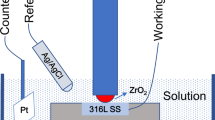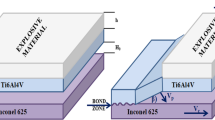We study the influence of the contact speed of friction surfaces on the tribocorrosion behavior of D16Т alloy in acid rain. It is shown that the electrode potential, the friction coefficient, and the loss of material in the course of tribocorrosion qualitatively are well correlate and depend on the velocity of mutual displacement of the surfaces of friction couples. It is demonstrated that the activation potential, corrosion potential, and tribological potential enable one to estimate the fracture mechanism of materials passivated in corrosive media.






Similar content being viewed by others
References
V. I. Pokhmurs’kyi and V. M. Dovhunyk, “Tribocorrosion of stainless steels,” Fiz.-Khim. Mekh. Mater., 46, No. 1, 76–85 (2010); English translation: Mater. Sci., 46, No. 1, 87–96 (2010).
S. Mischler, “Materials deterioration in tribocorrosion: mechanisms and modeling,” in: EUROCORR’07, Paper No. 1455, CD ROM (2007), pp. 1–10.
P. Pontiaux, F. Wenger, D. Drees, and J.-P. Celis, “Electrochemical techniques for studying tribocorrosion processes,” Wear, 256, 459–468 (2004).
D. Landolt and S. Mischler, Tribocorrosion of Passive Metals and Alloys, Woodhead, Cambridge, UK (2011).
I. Garcia, D. Drees, and J.-P. Celis, “Corrosion–wear of passivation materials in sliding contacts based on a concept of active wear track area,” Wear, 249, 452–460 (2001).
A. Yu. Pokhmurs’kyi, B. P. Rusyn, and Yu. V. Obukh, “Evaluation of the influence of pit-like defects on the strength of D16T sheet alloy,” Fiz.-Khim. Mekh. Mater., 48, No. 1, 95–99 (2012); English translation: Mater. Sci., 48, No. 1, 101–105 (2012).
B. P. Rusyn, R. V. Tors’ka, and A. Yu. Pokhmurs’kyi, “Modeling of the evolution of corrosion pitting with the use cellular automata,” Fiz.-Khim. Mekh. Mater., 50, No. 5, 74–80 (2014); English translation: Mater. Sci., 50, No. 5, 706–713 (2015).
V. I. Pokhmurskii, I. M. Zin, V. A. Vynar, O. P. Khlopyk, and L. M. Bily, “Corrosive wear of aluminum alloy in presence of phosphate,” Corr. Eng. Sci. Tech., 47, 182–187 (2012).
V. Pokhmurs’kyi, I. Zin’, and O. Khlopyk, “Regularities of repassivation of the mechanically activated aluminum surface in acidrain solution in the presence of phosphate and nitrate inhibitors,” Fiz.-Khim. Mekh. Mater., Special Issue No. 10, 399–403 (2014).
http://home.ufam.edu.br/berti/nanomateriais/8403_PDF_CH07.pdf
Author information
Authors and Affiliations
Corresponding author
Additional information
Translated from Fizyko-Khimichna Mekhanika Materialiv, Vol. 53, No. 5, pp. 123–128, September–October, 2017.
Rights and permissions
About this article
Cite this article
Vynar, V.А., Pokhmurs’kyi, V.І., Zin’, І.М. et al. Determination of the Mechanism of Tribocorrosion of D16T Alloy According to the Electrode Potential. Mater Sci 53, 717–723 (2018). https://doi.org/10.1007/s11003-018-0128-9
Received:
Published:
Issue Date:
DOI: https://doi.org/10.1007/s11003-018-0128-9




